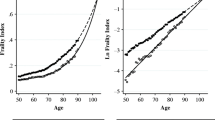Abstract
In a recent paper, Hashimoto and Tabata (J Popul Econ 23:571–593, 2010) present a theoretical model in which the increase in the rate of dependence due to aging of the population leads to a reallocation of labor from non-health to health production and, as a consequence, to a decline in economic growth. We argue that these results rely heavily on assumptions of a “small economy” and perfect capital mobility, which tie down the amount of capital. In this paper, we proceed by analyzing the case of an economy in which the availability of capital is endogenously determined by domestic savings. We find that the new “capital accumulation effect” is opposite to the previous “dependency rate effect,” leaving the effect on economic growth ambiguous. In particular, if the former prevailed, population aging would foster economic growth, a result that finds support in recent empirical work.




Similar content being viewed by others
Notes
The costs of raising and educating children are exclusively in terms of time.
The function in Eq. 14 may be convex, concave, or linear, depending on the value of θ.
Note that the wage rate in Eq. 8 is related positively with labor productivity in the non-health sector. Although the relationship appears to also be positive with labor productivity in the health sector in Eq. 9, the parallel decline in the relative price of health goods (see Eq. 10) cancels the positive effect.
References
Acemoglu D, Johnson S (2007) Disease and development: the effect of life expectancy on economic growth. J Polit Econ 115(6):925–985
Acemoglu D, Johnson S (2009) Disease and development: a reply to Bloom, Canning, and Fink. Working paper, http://econ-www.mit.edu/files/4491
Adams N (1971) Dependency rates and saving rates: comments. Am Econ Rev 61:472–475
Bloom D, Canning D, Sevilla J (2004) The effect of health on economic growth: a production function approach. World Dev 32(1):1–13
Bloom DE, Canning D, Fink G (2009) Disease and development revisited. NBER Working Paper 15137
Bloom DE, Canning D, Fink G (2011) Implications of population ageing for economic growth. Oxf Rev Econ Policy 26(4):583–612
Edwards S (1996) Why are Latin America’s saving rates so low? An international comparative analysis. J Dev Econ 51:5–44
Goldberger AS (1973) Dependency rates and saving rates: comment. Am Econ Rev 63:232–233
Gupta KL (1971) Dependency rates and saving rates: comment. Am Econ Rev 61:469–471
Hashimoto K, Tabata K (2010) Population aging, health care, and growth. J Popul Econ 23:571–593
Li H, Zhang J, Zhang J (2007) Effects of longevity and dependency rates on saving and growth: evidence from a panel of cross countries. J Dev Econ 84:138–154
Lindh T, Malmberg B (2009) European Union economic growth and the age structure of the population. Econ Change Restruct 42:159–187
Mullan F (2005) The metrics of the physician brain drain. N Engl J Med 353:1810–1818
Newhouse JP (1992) Medical care costs: how much welfare loss? J Econ Perspect 6(3):3–21
Prettner K (2012) Population aging and endogenous economic growth. J Popul Econ. doi:10.1007/s00148-012-0441-9
Ram R (1982) Dependency rates and aggregate savings: a new international cross-section study. Am Econ Rev 72:537–544
Ram R (1984) Dependency rates and aggregate savings: reply. Am Econ Rev 74:234–237
Reinhart VR (1999) Death and taxes: their implications for endogenous growth. Econ Lett 92:339–345
Sala-i-Martin X, Doppelhofer G, Miller R (2004) Determinants of long-term growth: a Bayesian averaging of classical estimates (BACE) approach. Am Econ Rev 94:813–835
Varvarigos D, Zakaria IZ (2012) Endogenous fertility in a growth model with public and private health expenditures. J Popul Econ. doi:10.1007/s00148-012-0412-1
Weil DN (2007) Accounting for the effect of health on economic growth. Q J Econ 122(3):1265–1306
Author information
Authors and Affiliations
Corresponding author
Additional information
Responsible editor: Junsen Zhang
Rights and permissions
About this article
Cite this article
Aisa, R., Pueyo, F. Population aging, health care, and growth: a comment on the effects of capital accumulation. J Popul Econ 26, 1285–1301 (2013). https://doi.org/10.1007/s00148-012-0448-2
Received:
Accepted:
Published:
Issue Date:
DOI: https://doi.org/10.1007/s00148-012-0448-2




